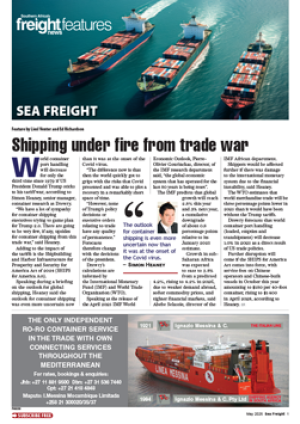It's porthole versus 40 ft integral reefer, writes Alan Peat
THE WORDS 40-foot integral reefer container are very much on the minds of SAECS (SA Europe Container Service) senior management, as the time approaches to decide on fleet replacement for the liner consortium.
The seven vessels in the fleet are homogenous - differing only in cosmetic details like colour scheme and number of funnels.
These 3 000 TEU (twenty foot equivalent unit) ships were all custom-built for the Europe-SA trade in 1977/78. This after an extensive survey, two years earlier, to determine the needs of the trade at the very inception of containerisation on the route.
At that time, the recommendation was that the conair (or ducted air) system of temperature control of containers was best suited to the trade - and some 25% of the entire TEU capacity was allocated to 20-foot conair slots. This, according to SAECS management, was a remarkably accurate assessment - as it has served the needs of shippers on the trade for well over two decades.
But the times they are a-changing and new market demands are now tending to over-ride the previous supremacy of the conair box.
The perishable export market in SA has now been deregulated and a flurry of smaller fruit farmers/ exporters has joined in the previously Unifruco/Outspan controlled trade. Larger numbers and smaller individual export volumes.
Also, in recent years, the lines (Safmarine in particular) have gone out of their way to encourage two other market factors.
First was the CA (controlled atmosphere) shipment of the exotic fruit and vegetable varieties - like avocados, asparagus and a number of others.
Secondly, there was a drive to widen the supply market. Shipments from the more remote areas of Southern Africa began to be targeted by the lines' marketing teams - also now offering a much wider range of destination markets than was previously available.
In all these cases, Safmarine insiders told FTW, the 40-ft integral reefers are more flexible in satisfying their market demands.
Not that the SAECS ships haven't got considerable 40-ft capacity. The lines have gradually increased the number of plug points for 40-ft integrals to 264 on each ship. Along with the conair slots, the result (well over
1 200 TEU slots) is a formidable reefer capacity. Well up to market demand - up to now.
But, if a fleet replacement decision is to be made - it has to be made soon. It's normally about 3-5 years between decision and going into service. And Safmarine's Howard Boyd hinted to FTW earlier this year that 2000 might mark the deciding point for vessel replacement.
Wim Lagaay of P&O Nedlloyd agrees.
I think it's a decision that has to be made this year, he said.
And, he added, the porthole versus the 40-ft integral will form a big part of that decision.
The crucial part of the consideration is that the porthole boxes are not interchangeable on a global scale, like integral reefer boxes, according to Lagaay.
With blown air containers, he said, you're trapped in that trade.
The integral reefers are used all over the world and can be repositioned all around the globe. That's another of the efficiencies they offer.
This will all have to be taken into consideration, according to Rod Riseborough, c.e.o. of SAECS.
With the re-tonnaging of these north-south trades, and the building of new vessels, the question of which reefer system to use is now being evaluated.
Undoubtedly, when the time comes for the SAECS vessels to be replaced, we will be faced with the same decision.
Copyright Now Media (Pty) Ltd
No article may be reproduced without the written permission of the editor
To respond to this article send your email to joyo@nowmedia.co.za
